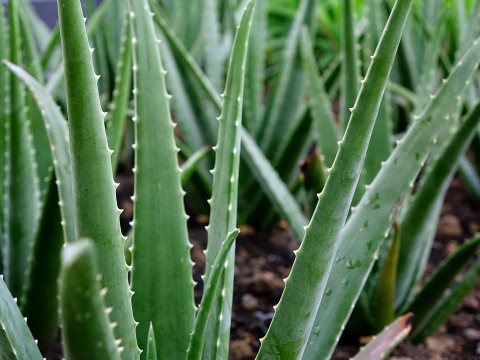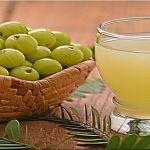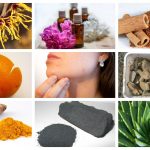Of late Aloe Vera has gained immense popularity thanks to its cooling and soothing properties that makes it the most efficient beauty and healthcare product. It will not be an overstatement if we call Aloe Vera an all-rounder in skin nourishment. Do you know that raw Aloe Vera plant gel contains 99.3% water and remaining 0.7% of the firm substance is composed of many nutrients like vitamins (C, E, B1, B2, B6, Folic acid, B12), amino acids; fatty acids that have anti-inflammatory properties; certain enzymes that have anti-oxidant properties.
In summers, it is very important to keep your skin hydrated as most of the moisture is lost due to high temperatures. Aloe Vera suits all skin types. It is a natural moisturizer, anti-ageing and a de-tan agent. It guards from the bad effects of sun burns and repairs the damaged skin. Because of this it is also known as, “the burn plant”. Let us have a glance at the benefits of Aloe Vera gel:
Benefits of Aloe Vera gel for skin:
Heals the damaged or broken skin– Aloe gel has wound healing ability. Have you ever noticed the self- repairing ability of an aloe leaf? If an aloe leaf is cut in the middle, it will heal the wound with its own gel and the leaf will continue to grow from the bottom. Similar effect is seen on human skin.
Aloe Vera has antiseptic properties that facilitate in healing burns and wounds. Research has shown the advantages of aloe gel for skin in healing 1st to second degree burns. The dynamic process of wound healing can be attributed to a complex carbohydrate called acemannan present in it that accelerates wound healing1. Also in recent analysis fresh aloe gel was found to be more effective than petroleum jelly based aloe creams .
Hydrates the skin– Aloe Vera balances the moisture levels in the skin, removes dead cells and therefore good for moisturizing the dry skin. The polysachcharides present in aloe vera are responsible for binding moisture into the skin. It prevents wrinkles and rejuvenates ageing skin. Zinc present in it acts as associate astringent to tighten the pores2. Apply it at nighttime before getting to bed and discover a soft and supple skin next morning.
Natural cooling agent– Aloe is great for removing the harmful effects of sunburn like redness, itchiness and tanning. Apply its gel on the burnt part. It will have a soothing result on skin because to its cooling properties. Its regular application can assist you regain your original complexion back.
Conditions the hair– Apply one tsp Aloe gel on your hair and wash it off after some time. It will not only clean but moisturize your hair leaving them soft and shiny.
Controls dandruff– Aloe vera is incredibly soothing for skin. It keeps the scalp moist and prevents flakiness. Mix Aloe gel with few drops of tea tree essential oil and massage your scalp twice every week with this mixture . It is found to control dandruff.
Lighten dark spots– Aloe gel promotes a fair skin tone and removes tanning of skin thereby giving a healthy complexion.
Antimicrobial in nature: Aloe is found to possess antibacterial, antiviral and antifungal properties due to presence of certain antiseptic agents such as lupeol, salicylic acid, phenols, sulphur and saponins. Saponins are soapy substances present within the aloe gel accountable for cleansing action on skin besides being antimicrobial. Aloe vera gel is known to treat acne.

Why do you need Aloe Vera gel?
Our skin is daily exposed to harmful effects of pollution and sun’s UV rays – which successively forms free radicals leading to compromised collagen and elastin fibers in our skin that gives us dry, wrinkled and ageing look. Also, as the age advances, the elastin of our skin becomes loose and collagen (that keeps the skin tight) reduces resulting in wrinkles.
To protect our skin from the free radical damage, we need anti-oxidants. Although our body produces antioxidants naturally, we need to apply creams or gels rich in antioxidants along with dietary changes to combat the damage caused by free radicals. Aloe Vera is a natural antioxidant. Research has proved that daily massage with pure Aloe Vera gel can increase collagen formation, improve skin elasticity, and reduce damage caused by sun resulting in younger looking skin.
Current market practices in making Aloe Vera gel
Fresh Aloe vera remains viable for a week only. Its degradation begins as soon as the leaf is cut from the plant. Therefore to keep aloe vera gel commercially viable, preservatives are added. Look out for the list of ingredients at the back of the gel pack. Does it contain too many harsh preservatives and chemicals when the aim can be achieved with safer preservatives like sodium benzoate and potassium sorbate?
Additionally you may find a thickener such as carbomer, xanthan or sea weed in the aloe vera gel cream to give the gel its consistency which is ok because original consistency of aloe vera gel is incredibly thin liquid like. Here’s a list of a number of preservatives that is safe to be employed in aloe gel/cream:
- Potassium Sorbate: It’s a safe food preservative and an antimicrobial agent that stops spoilage of the gel/cream from bacterias, fungus, moulds and yeast.
- Sodium Benzoate: It’s a safe food preservative utilized in aloe gels and aloe based creams as an antifungal agent.
- Thickener: such as carbopol, xanthan gum or seaweed to give gel a thick consistency.
Aloe vera gel has so many outstanding benefits that infusing unnecessary and harmful chemicals can ruin its therapeutic qualities. Sometimes less is more!
How to choose pure Aloe Vera gel?
- See the Color: If you have ever peeled the skin of an Aloe Vera leaf you would have noticed that the natural color of Aloe Vera pulp is white or translucent and not green. So that’s the primary customary to settle on pure Aloe Vera gel – its color! Some leading companies sell green colored Aloe Vera gel which is artificially colored to attract people.
- Read the ingredients: To your surprise you will find a long list of chemicals in the ingredients. With aloe mentioned somewhere in the middle. That means Aloe Vera is not the main ingredient in the gel if it is not mentioned in the beginning. It is in traces in such gels. So can such brands provide you with the desired benefits of Aloe Vera gel?
- Aroma or fragrance: Does the aroma come from essential oil or is it artificially perfumed?
Many firms are making Aloe Vera gel but it’s vital to use it pure to get all its benefits. In order to get it pure, the best way is to make your own aloe vera gel by aloe houseplant. However, getting the pulp from aloe leaf is a little tedious process and secondly once you make the gel it will stay fine for a week or so only, then you have to make a fresh one.

Succulent aloe gel has immense skin care benefits and is useful in a variety of skin ailments such as acne, cuts, wounds, minor burns and eczema. It is antimicrobial and anti-inflammatory in nature. Its moisturizing and anti-ageing qualities make it one of nature’s best gifts to us.
So mollycoddle your skin with the supernatural properties of Aloe Vera gel this summer!
References
- Sahu P.K, Giri D et al. Therapeutic and Medicinal Uses of Aloe vera: A Review. Pharmacology & Pharmacy, 2013, 4, 599-610
- Surjushe A. et al. Aloe Vera: A short Review. Indian J Dermatol. 2008; 53(4): 163–166.






I loved as much as you will receive carried out right here. The sketch is attractive, your authored subject matter stylish. nonetheless, you command get bought an edginess over that you wish be delivering the following. unwell unquestionably come further formerly again as exactly the same nearly a lot often inside case you shield this hike.
Thankyou for being such an avid reader of all my blogs…and liking and appreciating them!
Appreciate you sharing, great post.Really looking forward to read more. Will read on…